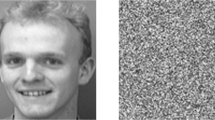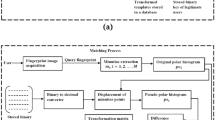Abstract
Biometric recognition, particularly fingerprint, has been widely adopted in many civil and military applications. However, security concerns have arisen regarding the protection of the saved biometric templates. If the fingerprints database is compromised, the person can no longer use his/her registered fingerprint for authentication. Cancelable biometrics have been used to overcome this issue, by transforming fingerprint templates to a secure representation before saving them on the database. The identity verification is performed in the transformed domain, and a new transform is assigned to a user if his/her biometric data is compromised. In this context, we propose a unique cancelable fingerprint scheme based on the extraction of Scale Invariant Feature Transform (SIFT) features from fingerprint minutiae positions. To provide cancelability, SIFT features are transformed by applying user-specific random projections, followed by quantization to ensure irreversibility. We successfully achieved a zero Equal Error Rate (EER) for the Fingerprint Verification Competition (FVC) 2002 DB1 benchmark in the different-key scenario, and 1.78 EER in the stolen-key scenario. We compare our results with state-of-the-art methods based on the EER metric in the stolen-key scenario. Genuine and impostor distributions have also been used for performance and security assessment of the proposed method. Moreover, we demonstrate the robustness of the proposed approach against brute force attacks.








Similar content being viewed by others
Data availability
The datasets generated during and/or analysed during the current study are available from the corresponding author on reasonable request.
References
Ahmad T, Hu J, Wang S (2011) Pair-polar coordinate-based cancelable fingerprint templates. Pattern Recogn 44:2555–2564. https://doi.org/10.1016/j.patcog.2011.03.015
Ajish S, Anil Kumar KS (2020) Security and performance enhancement of fingerprint biometric template using symmetric hashing. Comput Secur 90:101714. https://doi.org/10.1016/j.cose.2020.101714
Ali SS, Ganapathi II, Prakash S (2018) Robust technique for fingerprint template protection. IET Biometrics 7:536–549. https://doi.org/10.1049/iet-bmt.2018.5070
Ali SS, Ganapathi II, Prakash S, Consul P, Mahyo S (2020) Securing biometric user template using modified minutiae attributes. Pattern Recogn Lett 129:263–270. https://doi.org/10.1016/j.patrec.2019.11.037
Ali SS, Baghel VS, Ganapathi II, Prakash S (2020) Robust biometric authentication system with a secure user template. Image Vis Comput 104:104004. https://doi.org/10.1016/j.imavis.2020.104004
Arpit D, Nwogu I, Srivastava G, Govindaraju V (2014) An analysis of random projections in cancelable biometrics. Proc 31 st Int Conf Mach learn Beijing, China 32:
Atighehchi K, Ghammam L, Barbier M, Rosenberger C (2019) GREYC-hashing: combining biometrics and secret for enhancing the security of protected templates. Futur Gener Comput Syst 101:819–830. https://doi.org/10.1016/j.future.2019.07.022
Belguechi R, Rosenberger C, Ait-Aoudia S (2010) Biohashing for securing minutiae template. In: 2010 20th international conference on pattern recognition. IEEE, pp 1168–1171
Cavoukian A, Stoianov A (2007) Biometric encryption. Biometric Technol Today 15:11. https://doi.org/10.1016/S0969-4765(07)70084-X
Chikkerur S, Ratha NK, Connell JH, Bolle RM (2008) Generating registration-free cancelable fingerprint templates. In: 2008 IEEE second international conference on biometrics: theory, Applications and Systems. IEEE, pp. 1–6
Dasgupta S, Gupta A (2003) An elementary proof of a theorem of Johnson and Lindenstrauss. Random Struct Algorithms 22:60–65. https://doi.org/10.1002/rsa.10073
Demmel JW, Higham NJ (1993) Improved error bounds for underdetermined system solvers. SIAM J Matrix Anal Appl 14:1–14. https://doi.org/10.1137/0614001
Diephuis M, Voloshynovskiy S, Koval O, Beekhof F (2011) Statistical analysis of Binarized SIFT descriptors. In: 2011 7th international symposium on image and signal processing and analysis (ISPA). Pp 460–465
Djebli H, Ait-Aoudia S (2018) SAF-AFIS: SIFT-based alignment free approach for an automatic fingerprint identification system. In: International conference on pattern recognition and artificial intelligence ICPRAI 2018. Montréal, Canada, pp. 350–353
Feng YC, Yuen PC, Jain AK (2008) A hybrid approach for face template protection. In: Biometric Technology for Human Identification V, Proceedings of SPIE, p 694408
Gedalia Razafindrobelina N, Ahmad T (2020) Cancellable fingerprint generation by projection based transformation and quantization. In: 2020 international seminar on application for Technology of Information and Communication (iSemantic). IEEE, pp 286–291
Hämmerle-Uhl J, Pschernig E, Uhl A (2009) Cancelable Iris biometrics using block re-mapping and image warping. In: lecture notes in computer science (including subseries lecture notes in artificial intelligence and lecture notes in bioinformatics). Pp 135–142
ISO/IEC 24745 (2011) Information technology — Security techniques — Biometric Information Protection
Jacob IJ, Betty P, Darney PE, Raja S, Robinson YH, Julie EG (2021) Biometric template security using DNA codec based transformation. Multimed Tools Appl 80:7547–7566. https://doi.org/10.1007/s11042-020-10127-w
Jain AK, Ross A, Prabhakar S (2004) An introduction to biometric recognition. IEEE Trans Circuits Syst Video Technol 14:4–20. https://doi.org/10.1109/TCSVT.2003.818349
Jin ATB, Ling DNC, Goh A (2004) Biohashing: two factor authentication featuring fingerprint data and tokenised random number. Pattern Recogn 37:2245–2255. https://doi.org/10.1016/j.patcog.2004.04.011
Jin Z, Jin Teoh AB, Ong TS, Tee C (2012) Fingerprint template protection with minutiae-based bit-string for security and privacy preserving. Expert Syst Appl 39:6157–6167. https://doi.org/10.1016/j.eswa.2011.11.091
Jin Z, Lim M, Teoh ABJ, Goi B (2014) A non-invertible randomized graph-based hamming embedding for generating cancelable fingerprint template. Pattern Recogn Lett 42:137–147. https://doi.org/10.1016/j.patrec.2014.02.011
Karimovich GS, Turakulovich KZ (2016) Biometric cryptosystems: open issues and challenges. In: 2016 international conference on information science and communications technologies (ICISCT). IEEE, pp 1–3
Kaur H, Khanna P (2016) Biometric template protection using cancelable biometrics and visual cryptography techniques. Multimed Tools Appl 75:16333–16361. https://doi.org/10.1007/s11042-015-2933-6
Kaur H, Khanna P (2019) Random slope method for generation of cancelable biometric features. Pattern Recogn Lett 126:31–40. https://doi.org/10.1016/j.patrec.2018.02.016
Khan SH, Ali Akbar M, Shahzad F, Farooq M, Khan Z (2015) Secure biometric template generation for multi-factor authentication. Pattern Recogn 48:458–472. https://doi.org/10.1016/j.patcog.2014.08.024
Kho JB, Kim J, Kim I-J, Teoh ABJ (2019) Cancelable fingerprint template design with randomized non-negative least squares. Pattern Recogn 91:245–260. https://doi.org/10.1016/j.patcog.2019.01.039
Khodadoust J, Medina-Pérez MA, Monroy R, Khodadoust AM, Mirkamali SS (2021) A multibiometric system based on the fusion of fingerprint, finger-vein, and finger-knuckle-print. Expert Syst Appl 176:114687. https://doi.org/10.1016/j.eswa.2021.114687
Koval O, Voloshynovskiy S, Pun T (2008) Privacy-preserving multimodal person and object identification. In: Proceedings of the 10th ACM workshop on multimedia and security - MM&sec ‘08. ACM Press, New York, New York, USA, p 177
Lowe DG (2004) Distinctive image features from scale-invariant Keypoints. Int J Comput Vis 60:91–110. https://doi.org/10.1023/B:VISI.0000029664.99615.94
Maio D, Maltoni D, Cappelli R, Wayman JL, Jain AK (2002) FVC2002: second fingerprint verification competition. In: Object recognition supported by user interaction for service robots. IEEE Comput. Soc, pp. 811–814
Manisha KN (2020) Cancelable biometrics: a comprehensive survey. Artif Intell Rev 53:3403–3446. https://doi.org/10.1007/s10462-019-09767-8
Mehmood R, Selwal A (2020) Polynomial based fuzzy vault technique for template security in fingerprint biometrics. Int Arab J Inf Technol 17:926–934. https://doi.org/10.34028/iajit/17/6/11
Neurotechnology VeriFinger SDK. http://www.neurotechnology.com/megamatcher.html. Accessed 8 Nov 2022
Patel VM, Ratha NK, Chellappa R (2015) Cancelable biometrics: a review. IEEE Signal Process Mag 32:54–65. https://doi.org/10.1109/MSP.2015.2434151
Pillai JK, Patel VM, Chellappa R, Ratha NK (2010) Sectored random projections for cancelable Iris biometrics. In: 2010 IEEE international conference on acoustics, Speech and Signal Processing. IEEE, pp. 1838–1841
Quan F, Fei S, Anni C, Feifei Z (2008) Cracking cancelable fingerprint template of Ratha. In: 2008 international symposium on computer science and computational technology. IEEE, pp 572–575
Ratha NK, Connell JH, Bolle RM (2001) Enhancing security and privacy in biometrics-based authentication systems. IBM Syst J 40:614–634. https://doi.org/10.1147/sj.403.0614
Ratha NK, Chikkerur S, Connell JH, Bolle RM (2007) Generating cancelable fingerprint templates. IEEE Trans Pattern Anal Mach Intell 29:561–572. https://doi.org/10.1109/TPAMI.2007.1004
Sandhya M, Prasad MVNK (2015) K-nearest neighborhood structure (k-NNS) based alignment-free method for fingerprint template protection. In: 2015 international conference on biometrics (ICB). IEEE, pp 386–393
Sandhya M, Prasad MVNK (2017) Securing fingerprint templates using fused structures. IET Biometrics 6:173–182. https://doi.org/10.1049/iet-bmt.2016.0008
Sandhya M, Prasad MVNK, Chillarige RR (2016) Generating cancellable fingerprint templates based on Delaunay triangle feature set construction. IET Biometrics 5:131–139. https://doi.org/10.1049/iet-bmt.2015.0034
Sarkar A, Singh BK (2020) A review on performance,security and various biometric template protection schemes for biometric authentication systems. Multimed Tools Appl 79:27721–27776. https://doi.org/10.1007/s11042-020-09197-7
Sehar EU, Selwal A, Sharma D (2021) FinCaT: fingerprint cancellable template protection remediation schemes, challenges, and future directions. In: 2021 fourth international conference on computational intelligence and communication technologies (CCICT). IEEE, pp 260–267
Sharma P, Walia GS, Rohilla R (2020) Recent advancement in cancelable biometric for user recognition: a brief survey. In: 2020 9th international conference system modeling and advancement in research trends (SMART). IEEE, pp 137–146
Teoh ABJ, Yuang CT (2007) Cancelable biometrics realization with multispace random projections. IEEE Trans Syst Man Cybern Part B 37:1096–1106. https://doi.org/10.1109/TSMCB.2007.903538
Trivedi AK, Thounaojam DM, Pal S (2020) Non-invertible cancellable fingerprint template for fingerprint biometric. Comput Secur 90:101690. https://doi.org/10.1016/j.cose.2019.101690
Wang S, Hu J (2014) Design of Alignment-Free Cancelable Fingerprint Templates via curtailed circular convolution. Pattern Recogn 47:1321–1329. https://doi.org/10.1016/j.patcog.2013.10.003
Wang S, Hu J (2016) A blind system identification approach to cancelable fingerprint templates. Pattern Recogn 54:14–22. https://doi.org/10.1016/j.patcog.2016.01.001
Wang S, Yang W, Hu J (2017) Design of Alignment-Free Cancelable Fingerprint Templates with zoned minutia pairs. Pattern Recogn 66:295–301. https://doi.org/10.1016/j.patcog.2017.01.019
Weinzaepfel P, Jegou H, Perez P (2011) Reconstructing an image from its local descriptors. In: CVPR 2011. IEEE, pp 337–344
Wong WJ, Teoh ABJ, Wong MLD, Kho YH (2013) Enhanced multi-line code for minutiae-based fingerprint template protection. Pattern Recogn Lett 34:1221–1229. https://doi.org/10.1016/j.patrec.2013.03.039
Yang B, Hartung D, Simoens K, Busch C (2010) Dynamic random projection for biometric template protection. In: 2010 fourth IEEE international conference on biometrics: theory, Applications and Systems (BTAS). IEEE, pp. 1–7
Author information
Authors and Affiliations
Corresponding author
Ethics declarations
Conflict of interests
The authors declare that they have no known competing financial interests or personal relationships that could have appeared to influence the work reported in this paper.
Additional information
Publisher’s note
Springer Nature remains neutral with regard to jurisdictional claims in published maps and institutional affiliations.
Rights and permissions
Springer Nature or its licensor holds exclusive rights to this article under a publishing agreement with the author(s) or other rightsholder(s); author self-archiving of the accepted manuscript version of this article is solely governed by the terms of such publishing agreement and applicable law.
About this article
Cite this article
Djebli, H., Ait-Aoudia, S. & Michelucci, D. Quantized random projections of SIFT features for cancelable fingerprints. Multimed Tools Appl 82, 7917–7937 (2023). https://doi.org/10.1007/s11042-022-13646-w
Received:
Revised:
Accepted:
Published:
Issue Date:
DOI: https://doi.org/10.1007/s11042-022-13646-w




